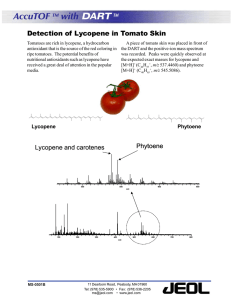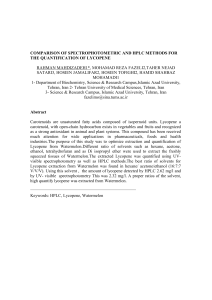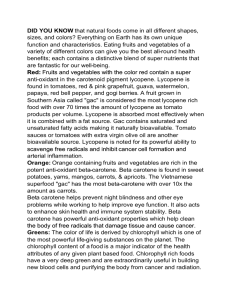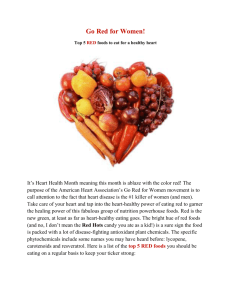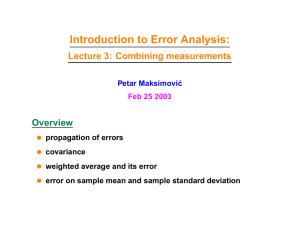Full text
advertisement
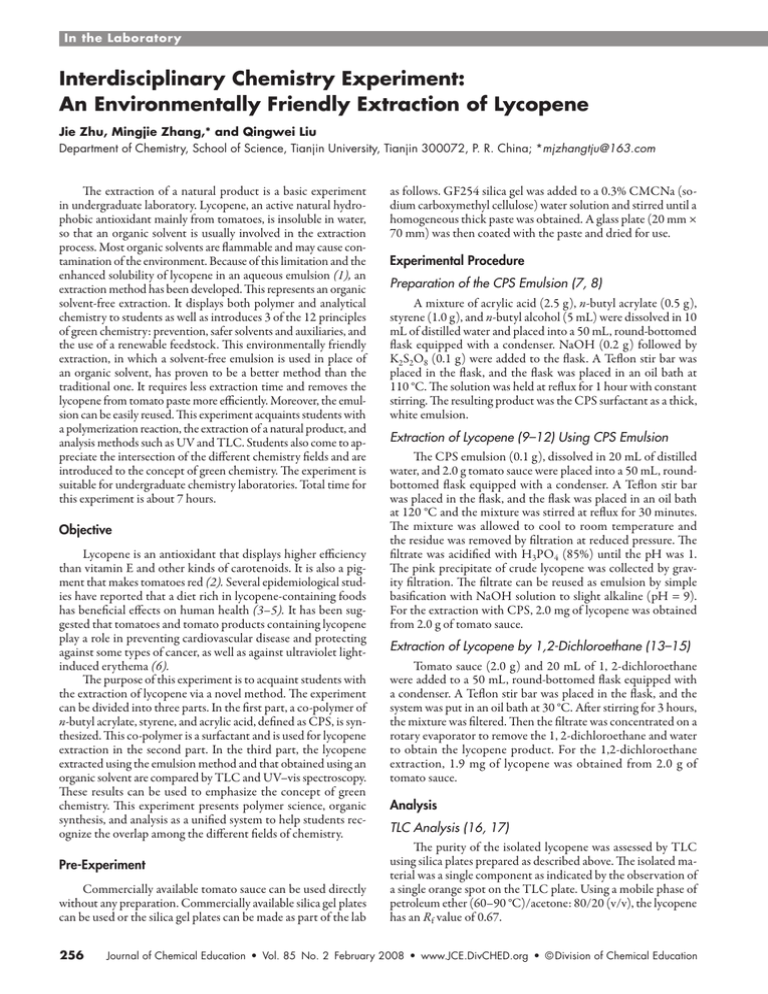
In the Laboratory Interdisciplinary Chemistry Experiment: An Environmentally Friendly Extraction of Lycopene Jie Zhu, Mingjie Zhang,* and Qingwei Liu Department of Chemistry, School of Science, Tianjin University, Tianjin 300072, P. R. China; *mjzhangtju@163.com The extraction of a natural product is a basic experiment in undergraduate laboratory. Lycopene, an active natural hydrophobic antioxidant mainly from tomatoes, is insoluble in water, so that an organic solvent is usually involved in the extraction process. Most organic solvents are flammable and may cause contamination of the environment. Because of this limitation and the enhanced solubility of lycopene in an aqueous emulsion (1), an extraction method has been developed. This represents an organic solvent-free extraction. It displays both polymer and analytical chemistry to students as well as introduces 3 of the 12 principles of green chemistry: prevention, safer solvents and auxiliaries, and the use of a renewable feedstock. This environmentally friendly extraction, in which a solvent-free emulsion is used in place of an organic solvent, has proven to be a better method than the traditional one. It requires less extraction time and removes the lycopene from tomato paste more efficiently. Moreover, the emulsion can be easily reused. This experiment acquaints students with a polymerization reaction, the extraction of a natural product, and analysis methods such as UV and TLC. Students also come to appreciate the intersection of the different chemistry fields and are introduced to the concept of green chemistry. The experiment is suitable for undergraduate chemistry laboratories. Total time for this experiment is about 7 hours. Objective Lycopene is an antioxidant that displays higher efficiency than vitamin E and other kinds of carotenoids. It is also a pigment that makes tomatoes red (2). Several epidemiological studies have reported that a diet rich in lycopene-containing foods has beneficial effects on human health (3–5). It has been suggested that tomatoes and tomato products containing lycopene play a role in preventing cardiovascular disease and protecting against some types of cancer, as well as against ultraviolet lightinduced erythema (6). The purpose of this experiment is to acquaint students with the extraction of lycopene via a novel method. The experiment can be divided into three parts. In the first part, a co-polymer of n-butyl acrylate, styrene, and acrylic acid, defined as CPS, is synthesized. This co-polymer is a surfactant and is used for lycopene extraction in the second part. In the third part, the lycopene extracted using the emulsion method and that obtained using an organic solvent are compared by TLC and UV–vis spectroscopy. These results can be used to emphasize the concept of green chemistry. This experiment presents polymer science, organic synthesis, and analysis as a unified system to help students recognize the overlap among the different fields of chemistry. Pre-Experiment Commercially available tomato sauce can be used directly without any preparation. Commercially available silica gel plates can be used or the silica gel plates can be made as part of the lab 256 as follows. GF254 silica gel was added to a 0.3% CMCNa (sodium carboxymethyl cellulose) water solution and stirred until a homogeneous thick paste was obtained. A glass plate (20 mm × 70 mm) was then coated with the paste and dried for use. Experimental Procedure Preparation of the CPS Emulsion (7, 8) A mixture of acrylic acid (2.5 g), n-butyl acrylate (0.5 g), styrene (1.0 g), and n-butyl alcohol (5 mL) were dissolved in 10 mL of distilled water and placed into a 50 mL, round-bottomed flask equipped with a condenser. NaOH (0.2 g) followed by K2S2O8 (0.1 g) were added to the flask. A Teflon stir bar was placed in the flask, and the flask was placed in an oil bath at 110 °C. The solution was held at reflux for 1 hour with constant stirring. The resulting product was the CPS surfactant as a thick, white emulsion. Extraction of Lycopene (9–12) Using CPS Emulsion The CPS emulsion (0.1 g), dissolved in 20 mL of distilled water, and 2.0 g tomato sauce were placed into a 50 mL, roundbottomed flask equipped with a condenser. A Teflon stir bar was placed in the flask, and the flask was placed in an oil bath at 120 °C and the mixture was stirred at reflux for 30 minutes. The mixture was allowed to cool to room temperature and the residue was removed by filtration at reduced pressure. The filtrate was acidified with H3PO4 (85%) until the pH was 1. The pink precipitate of crude lycopene was collected by gravity filtration. The filtrate can be reused as emulsion by simple basification with NaOH solution to slight alkaline (pH = 9). For the extraction with CPS, 2.0 mg of lycopene was obtained from 2.0 g of tomato sauce. Extraction of Lycopene by 1,2-Dichloroethane (13–15) Tomato sauce (2.0 g) and 20 mL of 1, 2-dichloroethane were added to a 50 mL, round-bottomed flask equipped with a condenser. A Teflon stir bar was placed in the flask, and the system was put in an oil bath at 30 °C. After stirring for 3 hours, the mixture was filtered. Then the filtrate was concentrated on a rotary evaporator to remove the 1, 2-dichloroethane and water to obtain the lycopene product. For the 1,2-dichloroethane extraction, 1.9 mg of lycopene was obtained from 2.0 g of tomato sauce. Analysis TLC Analysis (16, 17) The purity of the isolated lycopene was assessed by TLC using silica plates prepared as described above. The isolated material was a single component as indicated by the observation of a single orange spot on the TLC plate. Using a mobile phase of petroleum ether (60–90 °C)/acetone: 80/20 (v/v), the lycopene has an Rf value of 0.67. Journal of Chemical Education • Vol. 85 No. 2 February 2008 • www.JCE.DivCHED.org • © Division of Chemical Education 0.6 0.4 641 0.2 0.0 300 502 446 0.8 0.6 0.4 0.2 641 0.8 363 Absorbance 1.0 363 Absorbance 1.0 1.2 502 447 1.2 471 471 In the Laboratory 0.0 350 400 450 500 550 600 650 300 Wavelength / nm 350 400 450 500 550 600 650 Wavelength / nm Figure 1. Spectrum of lycopene in acetone. The lycopene was extracted from tomato paste using CPS. Figure 2. Spectrum of lycopene in acetone. The lycopene was extracted from tomato paste using 1,2-dichloroethane. UV–Vis Spectra Analysis (18, 19) Samples of lycopene (1.0 mg) obtained from each of the two methods were dissolved in 10 mL of acetone for UV– vis analysis. The spectra are shown in Figures 1 and 2. The absorption peaks at 447 (446), 471, and 502 nm represent characteristic absorptions for lycopene. Clearly, the material obtained from either extraction is lycopene and thus the emulsion extraction is a viable method for the extraction of lycopene from tomatoes. Literature Cited Hazards Acrylic acid and styrene are toxic and will cause contact burns and severe irritation if they come in contact with exposed skin or the respiratory system. n-Butyl alcohol is harmful by inhalation, ingestion, or skin absorption. It is an irritant, narcotic, and CNS depressant. n-Butyl acetate and 1,2-dichloroethane are flammable and harmful if swallowed or inhaled and in contact with the skin. 1,2-Dichloroethane is a probable human carcinogen. All polymerization steps should be carried out in a wellventilated fumehood and gloves should be worn at all times. Results and Discussion Emulsion extraction has been shown to be a viable, environmentally friendly method for the extraction of lycopene from tomatoes. Compared with the traditional methods, it is more efficient, uses no organic solvents, and is suitable for an undergraduate laboratory course. It illustrates several of the principles of green chemistry: • Prevent waste generation. There is no organic solvent used during extraction. • Use of renewable feedstock. The emulsifier can be easily reused. • Use of safer solvents. Water is the only solvent used during extraction process. The procedure permits a standard laboratory experiment to be carried out using an inexpensive, efficient, green chemistry approach. The incorporation into a laboratory course provides a basis for a discussion of the isolation and use of natural products; principles of extraction; polymer synthesis and properties; and the benefits of green chemistry. 1. Aviram, S.; Anan, Y.; Abraham, A.; Roy, E. H.; Nissim, G. J. Agric. Food Chem. 2002, 50, 6917. 2. Clinton, S. K. Nutr. Rev. 1998, 56, 35. 3. Arab, L.; Steck, S. Am. J. Clin. Nutr. 2000, 71, 1691S. 4. Sharoni, Y.; Danilenko, M.; Levy, J. Drug Dev. Res. 2000, 50, 448. 5. Willcox, J. K.; Catignani, G. L.; Lazarus, S. Crit. Rev. Food Sci. Nutr. 2003, 43, 1. 6. Shi, J.; Le Maguer, M. Crit. Rev. Food Sci. Nutr. 2000, 40, 1. 7. Bond, J.; Lee, P. I. J. App. Polymer Sci. 1969, 13, 1215. 8. Roe, Charles P. Ind. Eng. Chem. 1968, 60, 20. 9. Goodrich, J.; Parker, C.; Phelps, R . J. Chem. Educ. 1993, 70, A158. 10. Taungbodhitham, A. K.; Jones, G. P.; Wahlqvist, M. L.; Briggs, D. R. Food Chem. 1998, 63, 577. 11. Lin, C. H.; Chen, B. H. J. Chromatogr. A 2003, 1012, 103. 12. Van den Berg, H.; Faulks, R.; Fernando-Granado, H.; Hirschberg, J.; Olmedilla, B.; Sandmann, G.; Southon, S.; Stahl, W. J. Sci. Food Agric. 2000, 80, 880. 13. Tzouganaki, Z. D.; Atta-Politou, J.; Koupparis, M. A. Analytica Chimica Acta. 2002, 467, 115. 14. Gerster, H. J. Am. Coll. Nutr. 1997, 16, 109. 15. Mortensen, A.; Skibsted, L. H. J. Agric. Food Chem. 1997, 45, 2970. 16. Tan, B.; Soderstrom, D. N. J. Chem. Educ. 1989, 66, 258. 17. Pfander, H.; Risen, R.; Niggli, U. Appl. Chem. 1994, 66, 947. 18. Ronman, P. J. Chem. Educ. 1985, 62, 540. 19. Catalin, M.; Tung-Ching L. J. Agric. Food Chem. 2005, 53, 8997. Supporting JCE Online Material http://www.jce.divched.org/Journal/Issues/2008/Feb/abs256.html Abstract and keywords Full text (PDF) Links to cited JCE articles Supplement Student procedures Instructor notes including the purpose of this experiment, background information of lycopene, chemicals with hazard information, and laboratory supplies © Division of Chemical Education • www.JCE.DivCHED.org • Vol. 85 No. 2 February 2008 • Journal of Chemical Education 257
